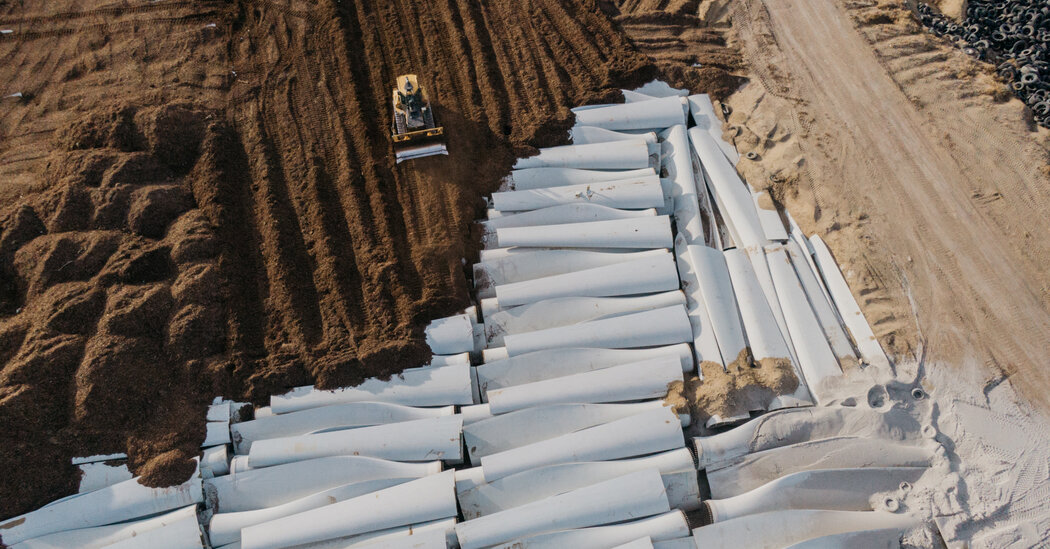Most wind turbine blades are longer than a soccer area and almost inconceivable to recycle.
On the finish of their lives of about 20 years, they’re chopped up and buried in a handful of landfills throughout the Nice Plains. These few locations in Wyoming, Iowa, and South Dakota have a spooky nickname: wind turbine graveyards.
However this waste downside from a rising low-carbon power supply might grow to be a headache of the previous.
Researchers on the Nationwide Renewable Vitality Laboratory have developed what they imagine is a turbine blade constituted of plant supplies that may be recycled. The brand new substance is constituted of inedible sugar extracted from wooden, plant residues, used cooking oil and agricultural waste.
They are saying the prototype they developed can work in addition to conventional blades, that are fabricated from a mix of fiberglass and plastic and had been very troublesome to reuse.
The brand new recyclable materials might simply be adopted by {industry}, mentioned Robin Murray, one of many researchers on the nationwide laboratory.
As a result of wind turbine blades are shaped in massive molds that may take up total warehouses and are costly to construct, it’s vital that any new materials be suitable with current molds and manufacturing services. And the substance developed by the nationwide laboratory does simply that, Dr. Murray mentioned.
It’s “designed to be an indispensable alternative,” she mentioned. “Producers ought to be capable to simply take it and use it.”
Blades constituted of the brand new supplies might be 3 to eight p.c dearer than conventional blades, according to one estimate.
As increasingly more wind farms are constructed across the nation, the disposal of outdated or damaged blades is an issue. Opponents of wind energy have seized on the difficulty as a purpose to attempt to block new wind services.
Greater than 1,000 blades are buried on the Casper Regional Landfill in Wyoming, which doesn’t settle for blades from different states. Wind vanes don’t emit poisonous substances when buried in landfills, however they take up quite a lot of house. Previous turbine blades as much as 120 toes lengthy are reduce into 40-foot sections earlier than disposal. The Casper landfill can maintain about 9,000 extra blades, based on a truth sheet supplied by metropolis officers.
Engineers count on greater than 43 million tons of landfill waste to be generated from turbine blades globally by 2050, which is about three times more total waste as a lot as New York produces yearly. The price of disposing of wind vanes might be a lot greater in different nations with a smaller land space and better inhabitants density than the USA. Some European nations – together with Germany, Austria, Finland and the Netherlands – have banned turbine blades from landfills.
Recycling a turbine blade constituted of conventional supplies is almost inconceivable as a result of it is vitally troublesome to interrupt its sturdy chemical bonds as soon as the petrochemical-derived epoxy resin is poured right into a mould and cured right into a blade.
Some outdated blades have been repurposed into posts and park benches and utilized in bridge development. The blades can be chopped into filler or added to cement manufacturing. A seven-tonne blade that’s floor and despatched by way of a cement kiln can substitute 5 tonnes of coal, leading to fewer carbon emissions, according to the American Clean Energy Association.
However the brand new materials developed by scientists on the nationwide laboratory might be recycled by being dumped into a shower of methanol heated to about 440 levels Fahrenheit, which turns it into an elastic liquid that may be molded into a brand new form.
One other researcher on the Renewable Vitality Laboratory, Nicholas Rohrer, in contrast the recyclable materials to a cargo community through which engineers know a number of particular knots that may be simply untied.
“It is warmth plus a solvent,” Dr. Rohrer mentioned. “That can break it.”
To check the sturdiness of the brand new recyclable substance, the researchers constructed a prototype 30-foot wind blade and positioned it in a laboratory chamber designed to simulate 20 years of publicity to daylight, various temperature, humidity and different environmental elements. The fabric meets manufacturing necessities and withstands stress higher than conventional substances by some metrics, Dr. Murray mentioned.
The subsequent step for this recyclable substance is to create a full-scale blade about 45 toes lengthy and take a look at it, she mentioned.
It’s unclear whether or not producers would change processes to make use of the recyclable materials. All of it comes right down to price, mentioned Ali Gorashi, senior vp of power infrastructure at DNV, an power consulting agency.
The wind power {industry} faces sturdy financial pressures, partially attributable to excessive preliminary capital prices and excessive rates of interest. Investing in dearer recyclables might be troublesome, Mr. Gorashi mentioned. The federal authorities ought to lead efforts to make sure an industry-wide shift to recyclables by way of laws or subsidies, he mentioned.
“I do not see a lot incentive to recycle the outdated,” Mr Gorashi mentioned. “It is not simply concerning the technological and engineering feasibility, it is also concerning the manufacturing prices.”

